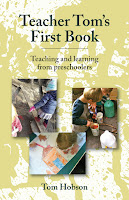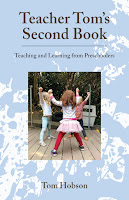"Wait a minute! I know how to play this game."
The children were standing around a table upon which were the tokens, dice and other parts and pieces from the board games Monopoly and The Game of Life. The night before, I had discovered, in my building's garbage room, that one of my neighbors had thrown out these brand new board games. I assume that it was the young couple from down the hall who had been talking for some time about hosting a game night for their friends.
And as a preschool teacher, I'm not above a little dumpster diving.
If you're familiar with these particular classic games, you know aren't designed for preschoolers, but I thought the kids would nevertheless get a kick out of the little houses and cars, the roulette wheel spinner, the stacks of phony money and whatnot. I had set the actual game boards aside, replacing them with a piece of white mat board that a previous group of children had used for an art project.
"I know how to play this," the boy insisted, as if convincing himself. He was taking in the scene, his eyes and hands darting from piece-to-piece, "I know how to play this."
Of course, he could not possibly know how to play this game because there was nothing to know; there was no game there. It wasn't a game at all, but rather a collection of game pieces. What he was reacting to was the idea of a board game, something he derived from previous experiences with these same, or similar, game pieces. He was making connections between his memories and the present. He was seeing patterns, interpreting them through the filter of experience, and, right there in front of everyone, constructing knowledge. "I know," he said.
Humans are born knowing no visual stories so the world they see is just a bunch of blobs. Likewise, smells and tastes begin as meaningless sensations. Newborns have, however, had the experience of listening to their world in utero, muffled by the womb, and so they are born knowing to attend, for instance, to their mother's voice: they turn their heads toward the familiar sound because a story about that voice has already started to form.
The human brain is a pattern-recognizing machine, one that cannot abide a story vacuum. So, just as the boy constructed the story of a game from those mixed up pieces, a baby begins, from the moment of birth, even before, constructing the story of mommy, connection, and love.
As adult humans, it's obvious to us that the crow in the tree over our heads is not actually smaller than the crow in the grass near our feet. Indeed, we treat perspective as a scientific and artistic truth, but the ability to perceive that is a story we constructed for ourselves. It's a story we've learned.
Not all the stories we tell ourselves throughout our lives, turn out to be true. The patterns we think we've identified, the connections we've made between things, might turn out to be wrong or at least not the same as the way other people do it, resulting in a different story. Our conflicts are always disagreements over stories.
By the same token, our greatest achievements emerge from working together to fill the vacuum with a common story. As the boy began to share with the other children about this game he "knew," they began to join in, asking questions, making their own assertions, and even negotiating exactly what this game was all about. The story of the game that emerged was not the one that we adults with our more detailed experience with board games in general, and these board games in particular, would have told. This was a fresh, new story.
So much of what passes for education is adults trying to tell their same, old, tired stories to the children. Stories that may or may not be true. A play-based curriculum is one in which the children are free to do what our brains are designed to do, which is to construct their own learning. This is how our species progresses.
******
If you liked reading this post, you might also enjoy one of my books. To find out more, Click here!
"Ready for a book that makes you want to underline and highlight? One that makes you draw arrows and write 'THIS!!!!!' in the margin? Then you are in for a treat." ~Lisa Murphy, M.Ed., author and Early Childhood Specialist, Ooey Gooey, Inc.
I put a lot of time and effort into this blog. If you'd like to support me please consider a small contribution to the cause. Thank you!


